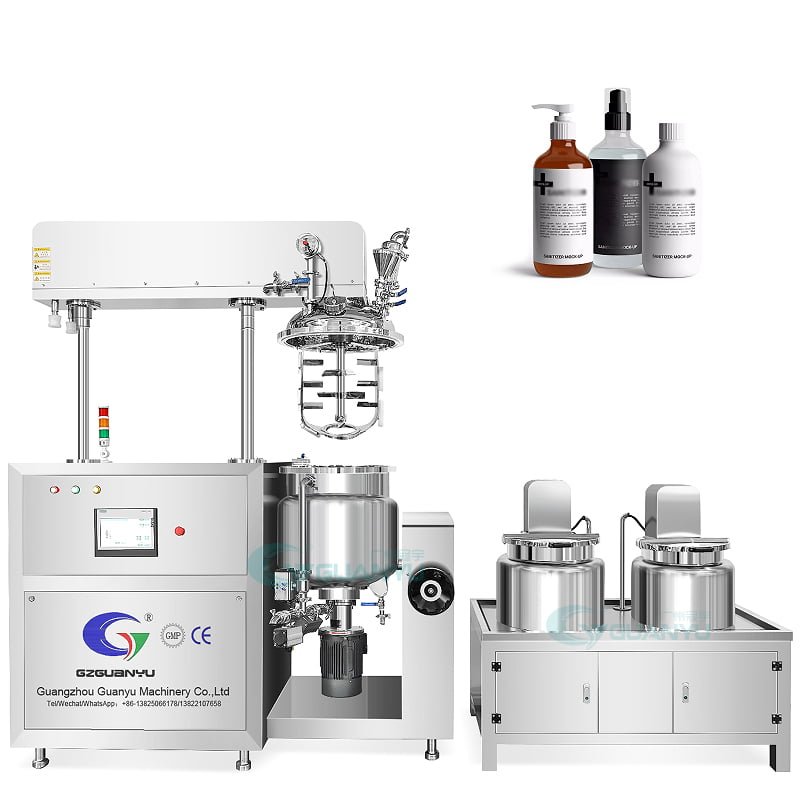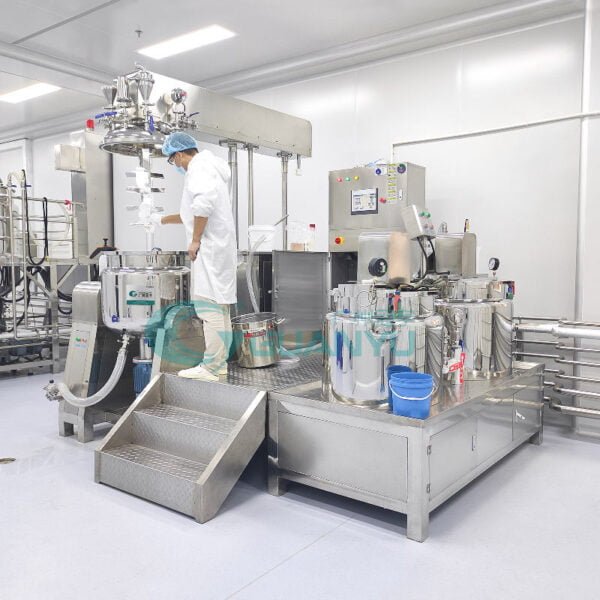Las máquinas emulsionantes de vacío son dispositivos industriales esenciales diseñados para mezclar, dispersar, y homogeneizar los materiales de manera eficiente. Estas máquinas se utilizan ampliamente en industrias como los cosméticos., productos farmaceuticos, producción de alimentos, y fabricación de productos químicos. Mediante el uso de la fuerza de corte de alta velocidad y operando en condiciones de vacío, Aseguran la mezcla estable de ingredientes que generalmente son incompatibles, como el aceite y el agua, dando lugar a la producción de emulsiones estables, crema, o pastas. En este artículo, Exploraremos los principios de trabajo., estructura, aplicaciones, y ventajas de las máquinas emulsionadoras al vacío.

Principios de funcionamiento de las máquinas emulsionantes al vacío
La función principal de una máquina emulsionante al vacío es combinar los ingredientes en una mezcla uniforme mediante cizallamiento mecánico y homogeneización., eliminando al mismo tiempo las burbujas de aire a través del sistema de vacío. El proceso se puede dividir en los siguientes pasos:
- Premezcla: Inicialmente, materias primas como líquidos, polvos, o se añaden sólidos al tanque de emulsión. Luego, un agitador realiza una mezcla preliminar para combinar los ingredientes..
- Homogeneización de alto cizallamiento: Próximo, Los materiales son procesados por un cabezal de corte de alta velocidad.. Este componente gira a una velocidad extremadamente alta., generando poderosas fuerzas de corte que descomponen los materiales en pequeñas partículas o gotas, Dispersar eficazmente ingredientes inmiscibles como aceite y agua., dando como resultado una mezcla uniforme.
- Antiespumante al vacío: El sistema de vacío elimina el aire atrapado durante el proceso de mezcla., evitando que se formen burbujas en el producto final. La ausencia de burbujas realza la textura., apariencia, y uniformidad de la mezcla. Además, el ambiente de vacío previene la oxidación, ayudando a mantener la calidad del producto y prolongando la vida útil.
- Enfriamiento y descarga: Después de los pasos de mezcla y homogeneización., El material se enfría a través de un sistema encamisado que rodea el tanque., asegurar que el producto alcance la temperatura óptima para su almacenamiento o envasado. Luego, el producto se descarga a través de una válvula para su posterior procesamiento o envasado..
Componentes clave de Máquinas emulsionantes al vacío
Las máquinas emulsionantes al vacío constan de varios componentes vitales que funcionan en conjunto para garantizar un alto rendimiento.:
- Tanque emulsionante: Este es el recipiente principal donde se mezclan los ingredientes.. Hecho de acero inoxidable, A menudo incluye camisas de calentamiento y enfriamiento para mantener un control preciso de la temperatura durante todo el proceso..
- Cabezal de alto corte: El cabezal de alto cizallamiento es responsable de descomponer y dispersar los ingredientes en pequeñas partículas o gotas., asegurando una textura uniforme y una mezcla estable.
- Sistema de vacío: La bomba de vacío elimina el aire de la cámara de mezcla., Previniendo la formación de burbujas de aire y asegurando la pureza de la mezcla evitando la entrada de contaminantes..
- Sistema de calefacción/refrigeración: Para garantizar la temperatura de procesamiento correcta, El tanque tiene un sistema encamisado que puede calentar o enfriar el material según sea necesario..
- Sistema de control: Las máquinas emulsionadoras al vacío modernas suelen venir equipadas con PLC. (Controlador lógico programable) Sistemas que permiten a los operadores controlar y monitorear la temperatura., Velocidad de mezcla, y tiempo de procesamiento a través de una interfaz intuitiva.
Tipos de máquinas emulsionantes al vacío
Hay varios tipos de máquinas emulsionantes al vacío disponibles para satisfacer diferentes necesidades industriales.:
Máquinas emulsionantes de laboratorio: Se trata de máquinas más pequeñas que se utilizan en investigación y desarrollo para probar nuevas formulaciones y realizar producción a pequeña escala..




Máquinas emulsionantes a escala industrial: Estas máquinas a gran escala están diseñadas para la producción en masa., con mayor capacidad y eficiencia, haciéndolos ideales para industrias como la cosmética, producción de alimentos, y farmacéuticos.



Máquinas emulsionantes multifuncionales: Estas máquinas combinan varias funciones como mezclar, cizallamiento, homogeneización, pasar la aspiradora, calefacción, y enfriamiento, ofreciendo una gran flexibilidad para cumplir con requisitos de producción complejos.



Aplicaciones de las máquinas emulsionantes al vacío
- Industria cosmética: Las máquinas emulsionantes al vacío se utilizan ampliamente para producir productos para el cuidado de la piel y el cabello, como cremas., lociones, champús, y acondicionadores. Estas máquinas garantizan que los ingredientes activos se dispersen uniformemente., resultando en suave, estable, y productos de alta calidad.
- Industria Farmacéutica: En productos farmacéuticos, Las máquinas emulsionantes se utilizan para producir cremas., ungüentos, geles, y medicamentos líquidos. Estas máquinas suelen estar construidas con altos estándares sanitarios., Garantizar que el proceso de producción sea estéril y libre de contaminación..
- Industria alimentaria: Las máquinas emulsionantes al vacío se utilizan habitualmente en la producción de salsas., aderezo, productos lácteos, y otros alimentos procesados. Garantizan que los ingredientes se mezclen uniformemente y que la textura y el sabor del producto final sean consistentes..
- Industria química: En el sector químico, Estas máquinas se utilizan para producir pinturas., lubricantes, emulsiones, y agentes de limpieza. Mejoran la consistencia y estabilidad de los productos químicos., haciéndolos más efectivos y confiables.


Ventajas de las máquinas emulsionantes al vacío
- Homogeneización eficiente: Estas máquinas utilizan un cizallamiento de alta velocidad para garantizar que los ingredientes se mezclen completamente y se dispersen uniformemente., resultando en pequeños, gotitas o partículas de tamaño uniforme que contribuyen a una estabilidad, producto de alta calidad.
- Funcionalidad de vacío: El sistema de vacío elimina las burbujas de aire., asegurando una textura suave y evitando la oxidación, lo que podría afectar la estabilidad y vida útil del producto final..
- Control automatizado: Muchas máquinas emulsionantes al vacío están equipadas con sistemas de control PLC automatizados., permitiendo un control preciso sobre variables como la temperatura, velocidad, y tiempo. Esto mejora la eficiencia, reduce el error humano, y garantiza resultados consistentes.
- Multifuncionalidad: Combinando calefacción, enfriamiento, mezclando, y homogeneización en una sola máquina, Las máquinas emulsionantes al vacío pueden manejar una amplia gama de aplicaciones y procesos., mejorando la versatilidad y la productividad.
Conclusión
Las máquinas emulsionantes al vacío desempeñan un papel crucial en industrias donde la alta calidad, Las emulsiones y mezclas estables son esenciales.. De la cosmética a la farmacéutica, alimento, y productos químicos, estas máquinas permiten una eficiente, confiable, y producción de alta precisión. Con sus características avanzadas como la homogeneización de alto cizallamiento y la funcionalidad de vacío., Son herramientas indispensables para los fabricantes que buscan producir productos de primer nivel..



Gracias por compartir. Leí muchas de tus publicaciones de blog., Frío, tu blog es muy bueno.
King333casino, sounds regal, bien? It’s alright, not gonna lie. Could use a bit of a refresh, but the games are functional and get the job done. I’d say, manage your expectations, and you might have a good time. Verificar king333casino if you are curious!
CasinoPixbet? Yeah, I’ve seen that one around. The design looks pretty clean. Haven’t deposited yet, but it’s on my list. vale la pena echarle un vistazo, I reckon casinopixbet.